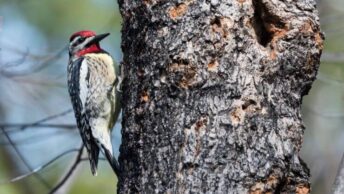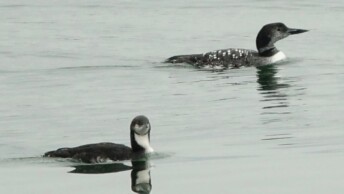Across North America, hummingbirds favor a wide range of brightly colored, tubular flowers rich in nectar. Among their top choices are plants from the Penstemon, Castilleja, and Salvia genera, which you can grow in your garden to attract these birds and support their feeding needs.
For this list, we focus on native flowering plants that serve as primary or supplementary food sources for hummingbirds across the United States and Canada. Based on field studies and ecological data, we’ve selected species that naturally occur in the wild and are also well-suited for garden cultivation.
For each plant, we provide key details on its appearance and relationship with hummingbirds, along with photos, native range, USDA hardiness zones, and bloom period. Most are perennials that are easy to grow and maintain under the right conditions.
Beardlip Penstemon
Penstemon barbatus
- Type: Perennial.
- Bloom period: May-October.
- Zones: USDA 4a-8b.
- Maintenance: Low.
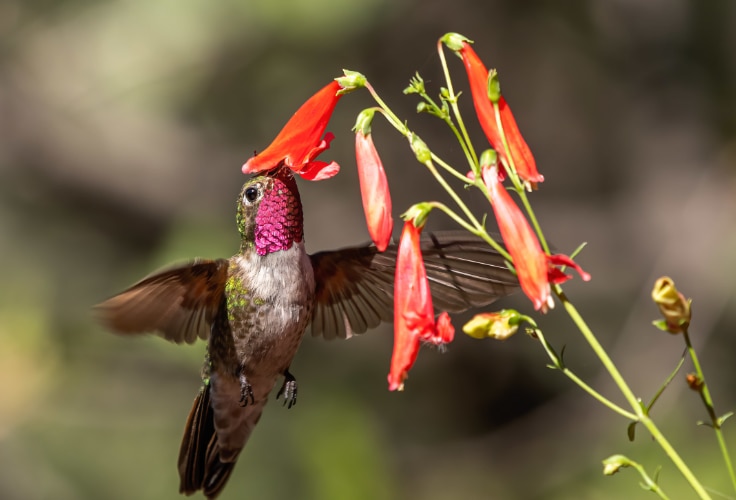
The beardlip penstemon is a tall, slender perennial known for its brilliant scarlet, tubular flowers that hang in loose clusters above upright stems. These blooms are a vital nectar source for hummingbirds in the Southwest, especially the Rivoli’s hummingbird, blue-throated mountain-gem, and calliope hummingbird. The flowers are two-lipped, with a hairy lower lip, and appear in abundance during the warmer months.
It is native to the southwestern United States, including Arizona, New Mexico, Utah, Colorado, and western Texas, where it grows on rocky mountain slopes, mesas, and open woodlands. The plant grows well in USDA zones 4a to 8b, and may survive in colder zones with protection.
Depending on the local climate, it can bloom from May through October. It thrives in full sun and prefers dry, rocky soils with good drainage. The beardlip penstemon is drought-tolerant and low-maintenance, benefiting from occasional deadheading and a cutback after flowering to maintain a tidy appearance.
Scarlet Indian Paintbrush
Castilleja coccinea
- Type: Annual or biennial.
- Bloom period: May to July.
- Zones: USDA 4a-8b.
- Maintenance: Medium to high.
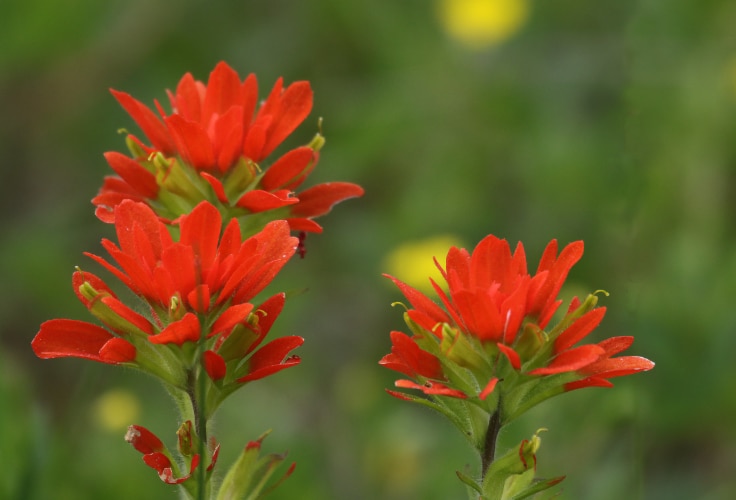
The scarlet Indian paintbrush is easily recognized by its vivid orange-red, fan-shaped bracts that resemble a brush dipped in paint. These showy structures nearly conceal the small greenish flowers tucked within. Among its primary pollinators is the ruby-throated hummingbird, which relies on the plant as a nectar source during its spring and early summer breeding range in the East.
Native to eastern and central North America, this species ranges from Maine and Ontario south to Florida and Louisiana, and west to Texas, Kansas, and Minnesota. It grows in meadows, open woodlands, glades, and prairies, favoring full sun and well-drained, often sandy soils. It is suitable for USDA zones 4a to 8b and can be grown in gardens.
The scarlet Indian paintbrush blooms from May through July, with plants often disappearing by midsummer after setting seed. It is semi-parasitic, drawing nutrients from the roots of neighboring plants, and can be difficult to maintain without compatible hosts. Successful cultivation may require repeated seeding and the presence of species such as native grasses or low-growing wildflowers.
Hummingbird Sage
Salvia spathacea
- Type: Perennial.
- Bloom period: March to May.
- Zones: USDA 8a-11b.
- Maintenance: Low.

The hummingbird sage is a fragrant, rhizomatous perennial known for its showy spikes of deep magenta, tubular flowers that rise above mounds of light green, wrinkled leaves. The blooms appear in dense whorls and are highly attractive to hummingbirds, especially Anna’s hummingbird and Allen’s hummingbird, which frequently visit the plant during its early spring flowering period.
Native to coastal and foothill regions of central and southern California, it typically grows in open or lightly shaded slopes below 600 meters (2,000 feet). It thrives in part shade with moist, well-drained soils but can adapt to drier conditions with occasional watering. It is suitable for USDA zones 8a to 11b and can be cultivated successfully in mild-winter gardens.
This species begins blooming as early as March and may continue into late spring, especially with some irrigation. It is low-maintenance and deer-resistant, with the added benefit of slowly spreading by underground rhizomes. Occasional deadheading and thinning of rhizomes help maintain its form and prevent overcrowding.
Red Buckeye
Aesculus pavia
- Type: Perennial.
- Bloom period: March to May.
- Zones: USDA 4a-8b.
- Maintenance: Medium.
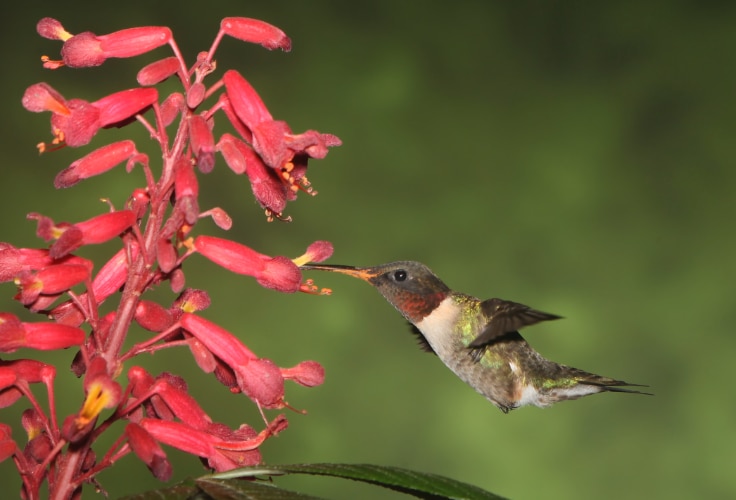
The red buckeye is a deciduous, multi-stemmed shrub or small tree valued for its showy clusters of red to orange-red, tubular flowers. The upright flower spikes can reach up to 10 inches long and are rich in nectar, making this species one of the most important early-season food sources for ruby-throated hummingbirds.
Native to the southeastern United States, the red buckeye occurs from North Carolina to Florida, west to central Texas, and north to southern Illinois. It grows in woodlands, along stream banks, and on rocky hillsides, preferring moist, acidic to neutral soils in part shade. It performs best in USDA zones 4a to 8b and benefits from protection against intense afternoon sun in hotter climates.
Flowering begins in early spring, often coinciding with the northward migration of hummingbirds. Although moderately drought-tolerant once established, the plant appreciates occasional deep watering during dry periods to delay leaf drop. It is easily grown from fresh seed and can begin flowering within a few years.
Scarlet Gilia
Ipomopsis aggregata
- Type: Biennial.
- Bloom period: August to October.
- Zones: USDA 6a-9b.
- Maintenance: Low.
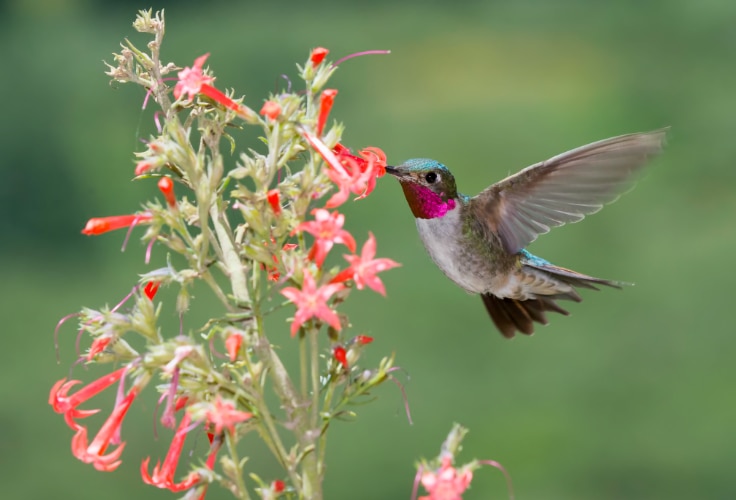
The scarlet gilia is a slender, upright wildflower known for its vibrant red, trumpet-shaped flowers that bloom in loose clusters near the tops of its sparsely leaved stems. The blossoms are long and tubular, flaring into five small lobes, perfectly adapted for hummingbird pollination. It is a critical late-season nectar source for several western species, most notably the rufous, calliope, and broad-tailed hummingbirds.
Native to western North America, the scarlet gilia ranges from southern British Columbia and Washington south to California and New Mexico, and eastward into Texas, Oklahoma, and the western Great Plains. It typically grows on open slopes, hillsides, and rocky outcrops in well-drained, sandy or loamy soils. The plant does best in full sun to partial shade and thrives in USDA zones 6a to 9b with minimal water needs.
This plant blooms from late summer into fall, bringing vibrant color to the landscape when few other wildflowers are still flowering. It is drought-tolerant and low-maintenance once established, although short-lived. As a biennial, it usually forms a basal rosette in its first year, then sends up a flowering stalk in the second. Though easy to grow from seed, it does not transplant well due to its taproot, and its success often depends on natural reseeding.
Firecracker Bush
Bouvardia ternifolia
- Type: Perennial.
- Bloom period: May to November.
- Zones: USDA 8a-11b.
- Maintenance: Low to medium.

The firecracker bush is a compact, upright shrub known for its vivid scarlet, trumpet-shaped flowers that appear in loose clusters at the tips of its many upright stems. Each flower features a long, narrow tube flaring into four bright red lobes, making it highly attractive to hummingbirds. It is especially important to Rivoli’s hummingbird, rufous hummingbird, and broad-tailed hummingbird, offering an extended nectar source throughout much of the year.
Native to dry mountain slopes and canyons of Arizona, New Mexico, and western Texas, it typically grows in rocky, well-drained soils ranging from sandy loam to clay and prefers full sun to partial shade. The firecracker bush is suited to USDA zones 8a to 11b and performs best in open areas with good air circulation.
The firecracker bush blooms profusely from late spring through fall and can even continue flowering into November in warmer climates. It is moderately drought-tolerant but benefits from occasional irrigation for better appearance and prolonged blooming. Though evergreen in frost-free areas, it becomes deciduous in colder zones. Maintenance is minimal – light pruning or deadheading helps keep the shrub compact and encourages new growth.
Jewelweed
Impatiens capensis
- Type: Annual.
- Bloom period: July to October.
- Zones: USDA 2a-11b.
- Maintenance: Low.
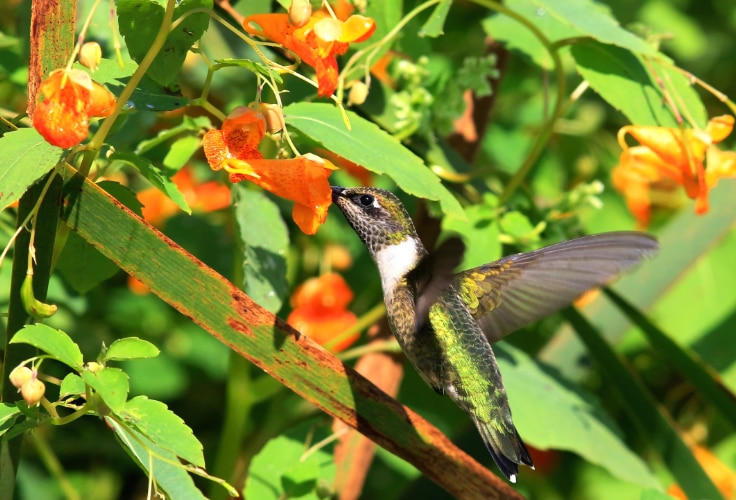
The jewelweed is a tall, moisture-loving annual known for its distinctive, pendulous orange flowers with red spots and a long rear spur. The flowers hang delicately from leaf axils and are perfectly shaped for hummingbird pollination, especially by the ruby-throated hummingbird, which is strongly associated with this species across its eastern range.
Native to shaded wetlands and moist lowlands throughout eastern and central North America, jewelweed is commonly found along forest edges, streams, and bog margins. It thrives in part to full shade and prefers rich, moist soils. It grows easily in USDA zones 2a to 11b and often forms dense colonies through prolific self-seeding. Although native and non-invasive, it can outcompete other vegetation in its favored habitat, sometimes suppressing invasive weeds like garlic mustard.
Flowering begins in midsummer and continues until frost. The jewelweed reseeds itself readily and can become a persistent presence in gardens with damp soil and shade. Its succulent stems are fragile but fast-growing, and the plant requires minimal care beyond ensuring moisture.
Scarlet Hedgenettle
Stachys coccinea
- Type: Perennial.
- Bloom period: March to October.
- Zones: USDA 6a-9b.
- Maintenance: Low to medium.
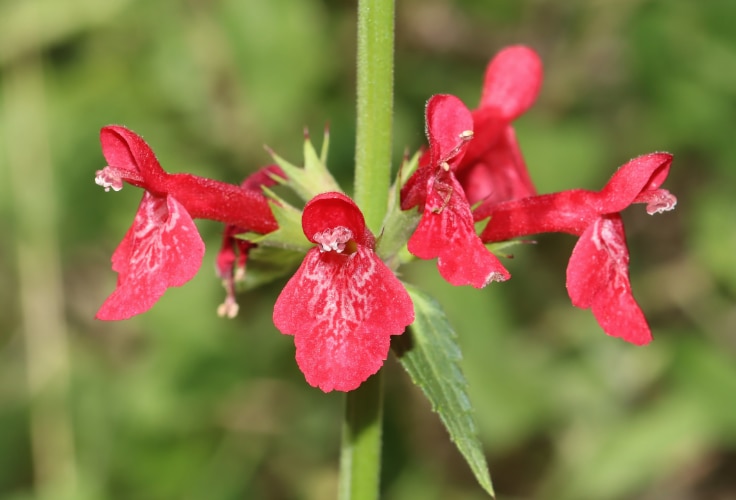
The scarlet hedgenettle is a stout, leafy perennial recognized for its bright red, tubular flowers arranged in loose, spike-like inflorescences. The square stems and soft, aromatic foliage give the plant a distinctive appearance, especially when paired with its long flowering season. Its nectar-rich blooms are a reliable food source for hummingbirds, particularly the rufous, broad-tailed, and blue-throated mountain-gem.
Native to the southwestern United States, including Arizona, New Mexico, and western Texas, this species is typically found on steep slopes, in canyon seeps, and other moist, rocky habitats. It thrives in part shade and prefers moist, well-drained soils, but tolerates full sun if soil moisture is adequate. Scarlet hedgenettle grows well in USDA zones 6a to 9b and is a useful groundcover or border plant for shady areas.
Flowering begins in early spring and can continue into fall under favorable conditions. While generally low-maintenance, it performs best with consistent moisture during dry spells. Deer-resistant and aromatic, the scarlet hedgenettle spreads gradually by rhizomes and can be lightly pruned to encourage a compact habit and more blooms.
Thurber’s Desert Honeysuckle
Anisacanthus thurberi
- Type: Perennial.
- Bloom period: March to May.
- Zones: USDA 8b-11b.
- Maintenance: Low.
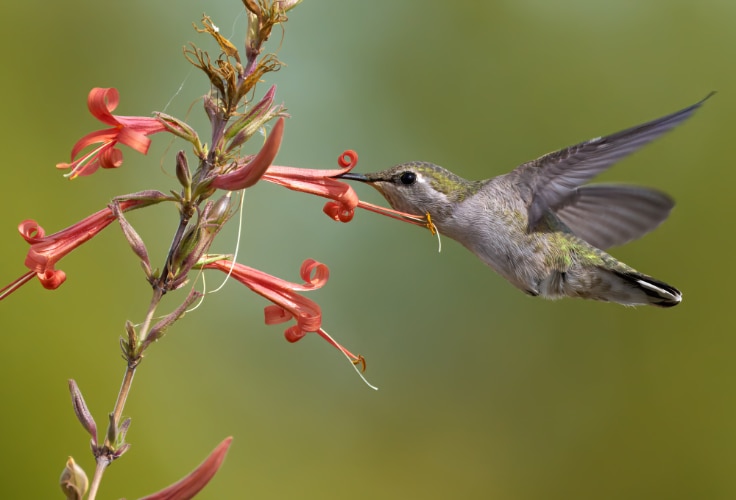
Thurber’s desert honeysuckle is a tall, airy shrub with stout, pale-barked stems and showy, tubular flowers in shades of red, orange, or occasionally yellow. Though unrelated to true honeysuckles, its blooms have a similar shape and are a strong draw for hummingbirds. The plant is especially valuable to nectar-feeding species like the black-chinned hummingbird and blue-throated mountain-gem.
Native to southern Arizona and southwestern New Mexico this species grows on rocky canyon walls, floodplains, and desert washes. It prefers full sun and dry, well-drained, rocky soils. While relatively rare in the U.S., it is more widespread in its native range and is increasingly used in desert landscaping. It thrives with minimal irrigation and is well suited to low-water gardens in USDA zones 8b to 11b.
The main bloom period is from March to May, though flowering may continue sporadically throughout the year in response to rainfall. Thurber’s desert honeysuckle is drought-tolerant and requires little care once established. Occasional pruning can encourage denser growth and more flowers, making it a reliable and attractive choice for wildlife gardens in hot, arid regions.
Western Columbine
Aquilegia formosa
- Type: Perennial.
- Bloom period: May to August.
- Zones: USDA 3a-8b.
- Maintenance: Low.
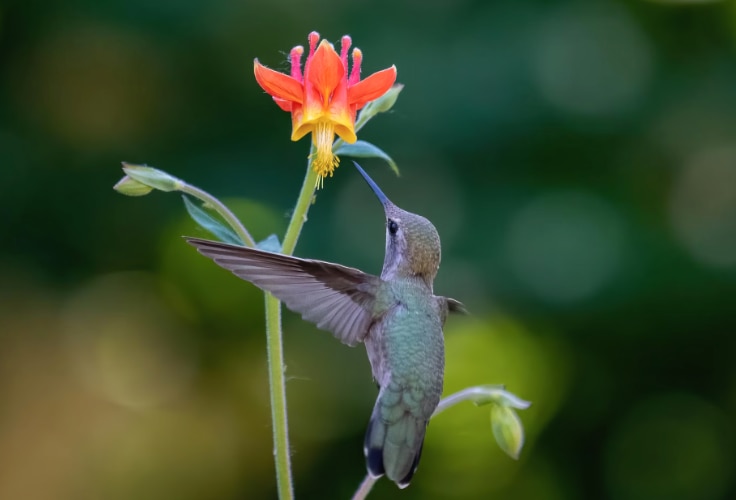
The western columbine is a delicate perennial with airy, blue-green foliage and nodding, red-and-yellow spurred flowers that resemble tiny lanterns. The nectar-rich blossoms are highly attractive to hummingbirds, especially the rufous hummingbird, which relies on it across its breeding range. Anna’s and Allen’s hummingbirds also visit the flowers regularly when in bloom.
Native to western North America, this species occurs from Alaska and western Canada south through the Pacific Northwest into Utah, Nevada, and California. It grows in moist, rocky soils along streambanks, forest edges, alpine meadows, and seeps. The western columbine tolerates both full sun and partial shade and thrives in USDA zones 3a to 8b, with possible survival into zone 9 in milder areas.
Flowering from late spring through summer, this plant readily reseeds and maintains itself in naturalized settings. It requires little maintenance beyond ensuring moist soil during dry periods, though it will tolerate drier, nutrient-poor soils once established. Its graceful form and dependable bloom make it a valuable addition to hummingbird gardens in cooler regions.
Cardinal Catchfly
Silene laciniata
- Type: Perennial.
- Bloom period: May to August.
- Zones: USDA 5b-9a.
- Maintenance: Medium.
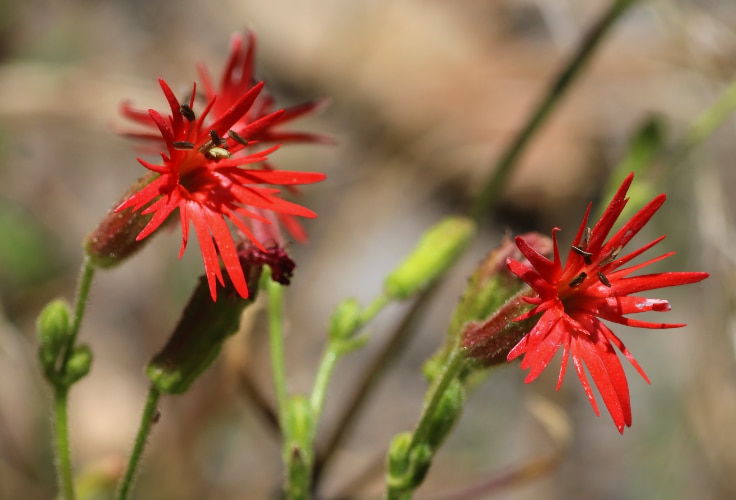
The cardinal catchfly is a slender, often sprawling perennial known for its vivid red, deeply notched, tubular flowers borne at the tips of long, weak stems. The jagged petals and bright color make it especially appealing to hummingbirds, with Allen’s hummingbird and Rivoli’s hummingbird among its most frequent visitors.
Native to the southwestern United States, including Arizona, New Mexico, Texas, and California, this species typically grows on pine-forested slopes, grassy clearings, or in brushy areas with filtered light. It thrives in part shade and prefers well-drained, gravelly soils rich in organic matter. The cardinal catchfly grows well in USDA zones 5b to 9a and is adaptable to a range of elevations and microclimates.
The pant blooms from late spring through summer and can be encouraged to re-bloom by cutting back spent stems. While not particularly demanding, its sprawling habit and sticky leaves may require some garden space or nearby vegetation for support. Easy to grow from seed or cuttings, this species offers long-lasting color and a reliable nectar source in hummingbird-friendly landscapes.
Cardinal Flower
Lobelia cardinalis
- Type: Perennial.
- Bloom period: May to October.
- Zones: USDA 3a-9b.
- Maintenance: Medium.
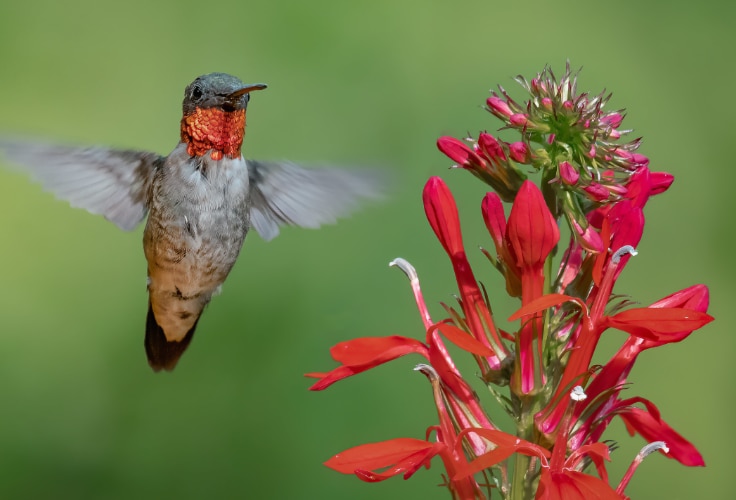
The cardinal flower is a striking clump-forming perennial best known for its vivid red, tubular blooms arranged in tall, upright spikes. Each flower features a fused corolla with a prominent three-lobed lower lip, making it especially well-suited for pollination by hummingbirds. It is a vital nectar source for the ruby-throated hummingbird and also supports black-chinned, rufous, and other hummingbird species as a supplementary food source.
Native to moist woodlands, stream banks, and low meadows throughout eastern and central North America, cardinal flower prefers humus-rich, wet soils and partial sun. It thrives in USDA zones 3a to 9b but performs best with constant moisture and protection from intense afternoon heat. In northern regions, a winter mulch is recommended to protect the roots and retain soil moisture.
Flowering begins in early summer and may continue until frost. The plant readily self-seeds under favorable conditions but may be short-lived if allowed to dry out. Propagation is easy from seed with cold stratification, or by layering stems into damp soil. While beautiful and ecologically valuable, all parts of the plant are toxic if ingested in large quantities and should be handled with care in gardens accessed by children or pets.
Wild Bergamot
Monarda fistulosa
- Type: Perennial.
- Bloom period: May to September.
- Zones: USDA 3a-9b.
- Maintenance: Medium.
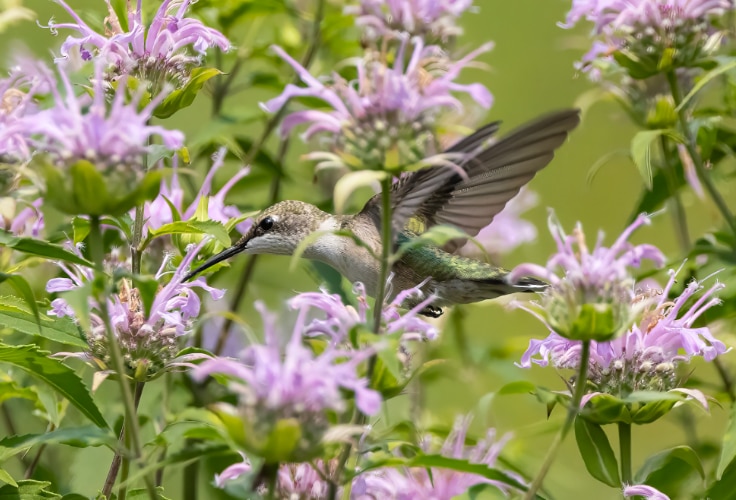
The wild bergamot, also known as bee balm, is a fragrant, clump-forming perennial with square stems and showy, lavender to pink flower heads that resemble ragged pompoms. Each two-lipped, tubular flower is held in a dense, terminal cluster atop upright stems, providing an abundant nectar source for ruby-throated hummingbirds across much of their breeding range.
Native to dry fields, meadows, and woodland edges throughout most of southern Canada and the U.S. east of the Rockies, this species thrives in a wide range of well-drained soils. It prefers full sun to part shade and performs well in USDA zones 3a to 9b. The wild bergamot tolerates drought once established and adapts to both acidic and alkaline soils, but benefits from good air circulation to reduce susceptibility to mildew.
Blooming begins in late spring and continues into early fall. Though low-maintenance, the plant spreads by rhizomes and may require division every few years to control its spread and maintain vigor. Deadheading spent flowers can extend the bloom period. With its minty aroma, attractive flowers, and ease of growth, wild bergamot is a valuable addition to hummingbird gardens, native plantings, and meadow borders.
Chiricahua Mountain Columbine
Aquilegia triternata
- Type: Perennial.
- Bloom period: May to October.
- Zones: USDA 6a-9b.
- Maintenance: Low.
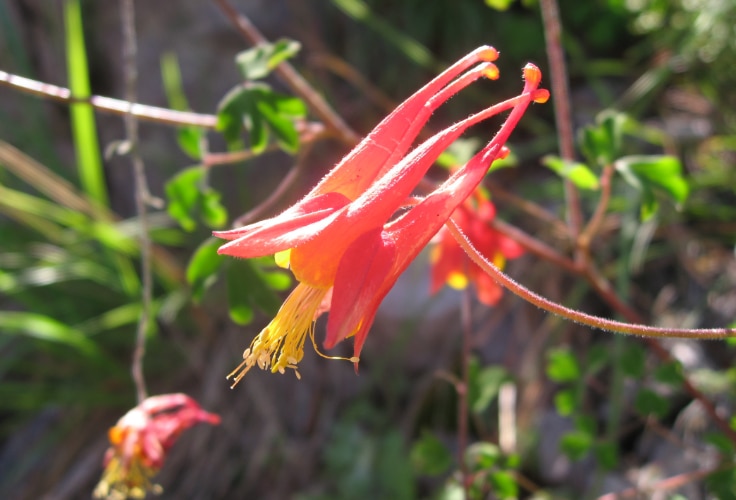
The Chiricahua Mountain columbine, also known as barrel columbine, is a small, delicate wildflower with nodding red and yellow flowers held on slender stems. Each bloom features backward-reaching red spurs and yellow petals that attract hummingbirds with their shape and nectar. It is a key nectar source for broad-tailed hummingbirds and Rivoli’s hummingbirds in its limited range.
This species is native to southeastern Arizona and adjacent parts of New Mexico, where it grows in moist, rocky openings at mid elevations. It prefers partial sun to light shade and requires moist, well-drained soils to thrive. Though not widely cultivated, it is suitable for hummingbird gardens and native plantings in USDA zones 6a to 9b, especially in areas with cool nights and reliable soil moisture.
Blooming from late spring into early fall, this columbine adds long-lasting color and pollinator value in lightly shaded garden settings. It is deciduous and easy to maintain, with little care needed beyond watering during extended dry periods. Like many columbines, it will reseed modestly in favorable conditions, helping to sustain local hummingbird foraging corridors.
Southern Bush Monkeyflower
Diplacus longiflorus
- Type: Perennial.
- Bloom period: March to July.
- Zones: USDA 8a-11b.
- Maintenance: Medium.
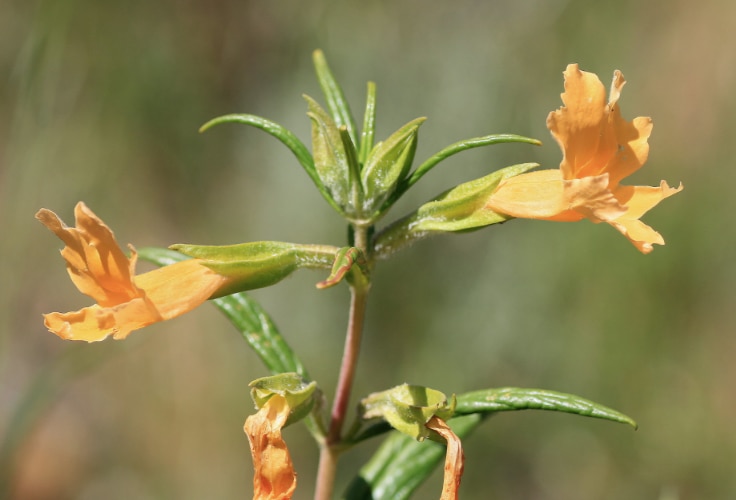
The southern bush monkeyflower is a compact, woody subshrub with soft, light green leaves and an abundance of tubular flowers that range in color from pale apricot to cream, sometimes appearing in rich yellows or reds in cultivated varieties. The flowers have a wide, open mouth, reminiscent of a “monkey face,” and are highly attractive to hummingbirds. It is a key nectar source for Anna’s hummingbird and Costa’s hummingbird along the southern California coast.
Native to dry slopes and foothills of central and southern California, this species grows at elevations up to 1,500 meters (5,000 feet). It prefers dry, rocky soils and does best in part shade or filtered sun. The southern bush monkeyflower is well adapted to the Mediterranean climate and is suitable for gardens in USDA zones 8a to 11b. It tolerates drought, heat, and poor soils, especially in its natural form, which is hardier than many cultivated varieties.
Flowering begins in early spring and may continue into midsummer depending on local conditions. Although drought-tolerant, the plant can become woody and brittle over time, so occasional pruning is recommended to maintain a compact, healthy form. Easy to grow from seed or cuttings, it provides dependable color and hummingbird support in dry native gardens.
Chaparral Currant
Ribes malvaceum
- Type: Perennial.
- Bloom period: February to May.
- Zones: USDA 7a-10b.
- Maintenance: Low.
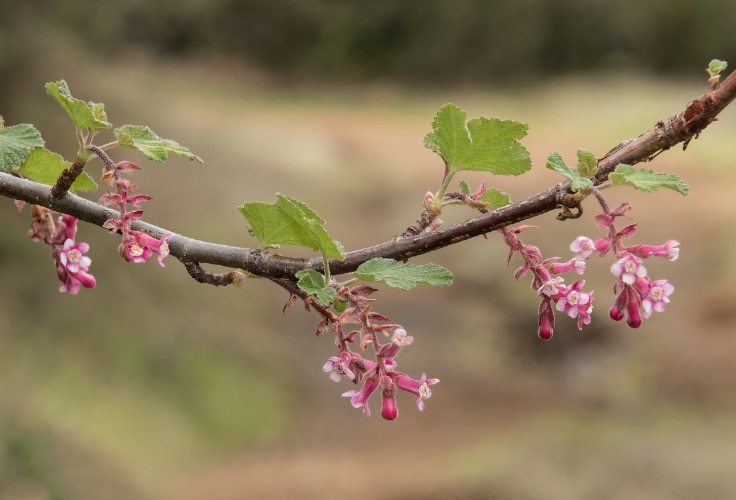
The chaparral currant is a drought-tolerant deciduous shrub with arching branches and clusters of hanging, pink flowers that bloom in late winter and early spring. The blossoms are a critical early-season nectar source for hummingbirds, especially Anna’s hummingbird, which relies on the species in places like the Santa Monica Mountains where few other flowers are available that early.
Endemic to California, chaparral currant is found in coastal scrub, foothills, and chaparral habitats. It grows well in full sun to partial shade and prefers well-drained soils. Suitable for USDA zones 7a to 10b, it may survive colder winters in zone 5, particularly in dry, sheltered conditions. Its ease of care and adaptability to drought make it well suited to native gardens and wildlife-friendly landscapes.
Blooming can begin as early as February, providing one of the first floral resources of the year. After flowering, the shrub produces small purple berries that attract a variety of birds. It requires little maintenance and thrives with minimal water once established, making it an ideal option for Mediterranean-climate gardens and low-water landscapes.
Havard’s Century Plant
Agave havardiana
- Type: Perennial.
- Bloom period: June to September.
- Zones: USDA 7a-10b.
- Maintenance: Low.
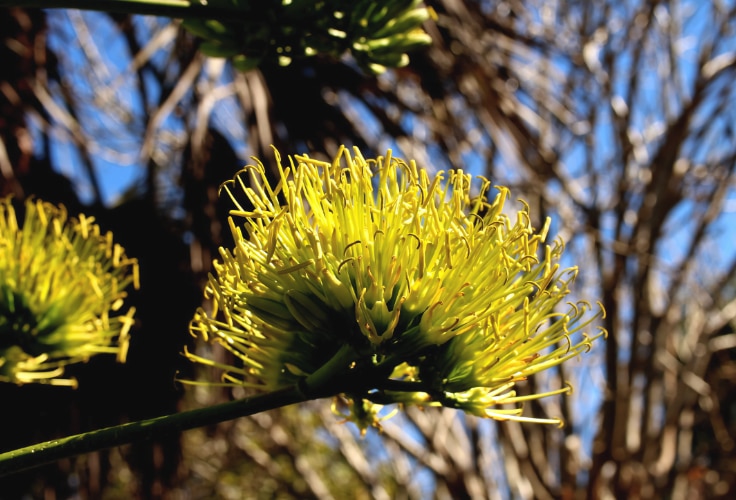
Havard’s century plant is a striking, slow-growing agave with dense rosettes of thick, blue-gray, spined leaves. Once in its lifetime, typically after 20 to 40 years, it sends up a towering flower stalk up to 15 feet tall, crowned with branching clusters of yellow-green blossoms. These blooms provide a valuable nectar source for hummingbirds in arid mountain regions, particularly the lucifer hummingbird, blue-throated mountain-gem, and black-chinned hummingbird.
Native to the Chihuahuan Desert of western Texas and northern Mexico, this species grows on rocky slopes, outcrops, and grasslands at elevations between 1,200 and 1,800 meters (4,000-6,000 feet). It thrives in full sun and dry, well-drained soils and is remarkably hardy, tolerating temperatures as low as -20°F in dry conditions. Havard’s agave is best suited for USDA zones 7a to 10b but can survive even in colder zones if winter moisture is minimal.
Blooming occurs in summer, typically between June and September. Each rosette flowers only once before dying, though mature plants may occasionally produce offsets. This drought-tolerant species requires little care beyond ensuring sharp drainage and minimal winter wetness. With its architectural form and resilience, it makes an excellent accent for xeriscapes, rock gardens, and desert landscapes.
Do Hummingbirds Prefer Certain Flower Colors?
Studies consistently show that hummingbirds strongly prefer red and reddish-orange flowers. However, their choices are not based on color alone.
Hummingbirds possess tetrachromatic vision, meaning they have four types of color receptors, including one for ultraviolet (UV) light). This allows them to perceive a vast range of colors, including UV-based combinations that humans cannot see, such as UV+red and UV+green.
Field experiments using real flowers and LED light sources reveal that hummingbirds reliably favor flowers reflecting red and UV wavelengths, but also rapidly learn to associate other colors with nectar rewards. They can distinguish subtle hue differences and adjust their preferences based on nectar quality, feeder location, and territorial behavior.
While red flowers may be less attractive to bees, reducing competition for nectar, hummingbirds rely on a hierarchy of cues: nectar concentration is most important, followed by position and then color.
So, although red flowers dominate in many hummingbird-pollinated plant species, the birds’ preferences are highly flexible and shaped by both biology and experience.

